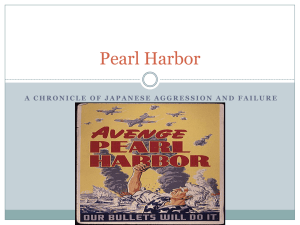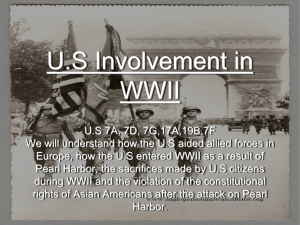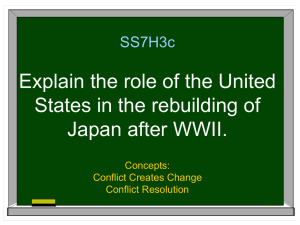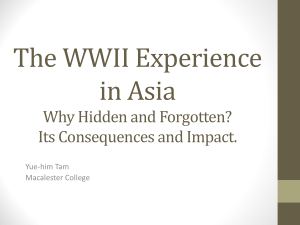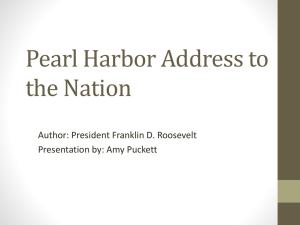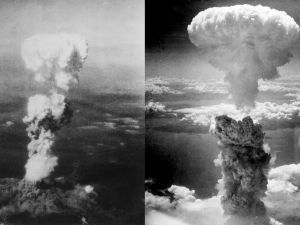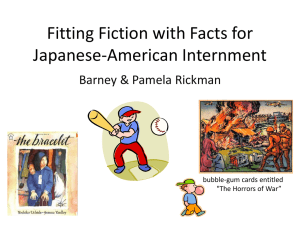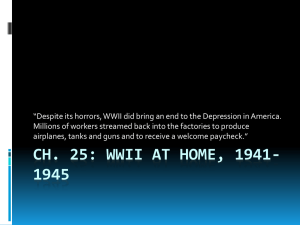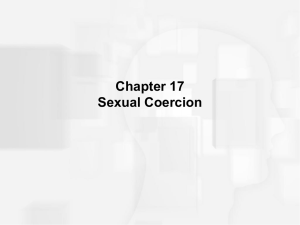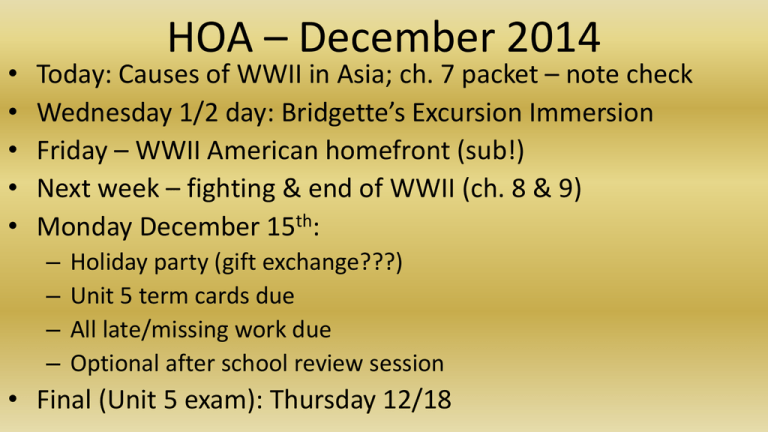
•
•
•
•
•
HOA – December 2014
Today: Causes of WWII in Asia; ch. 7 packet – note check
Wednesday 1/2 day: Bridgette’s Excursion Immersion
Friday – WWII American homefront (sub!)
Next week – fighting & end of WWII (ch. 8 & 9)
Monday December 15th:
–
–
–
–
Holiday party (gift exchange???)
Unit 5 term cards due
All late/missing work due
Optional after school review session
• Final (Unit 5 exam): Thursday 12/18
Have a holly jolly Christmas
Causes of WWII in the Pacific
Establishment of Japanese militarism
and the end of U.S. neutrality
Who is to blame? How does it compare
to Hitler’s aggression in Europe?
•
•
•
•
•
•
•
•
•
Background & Long-Term Causes
Discuss: Who was Matthew Perry? How did he change Japanese foreign policy?
1600-1853: Feudal state, completely isolated, no political/economic allies
1853: Open Door Policy
1867: Power handed back to emperor
– Period of modernization, industrialization, militarization, education, trade, etc.
1895: victory over China (1st war)
– West views Japan as first non-European world power
Imperialism & expansionist foreign policy leads to development of a strong military (Why did
the military have a continuous influence over the government?)
1902: Anglo-Japanese Alliance (Why did England agree to an alliance?)
1904: Russo-Japanese War (creates tension between countries into WWII)
1905: victory over Russia (both competing for influence in the region)
– Encouraged Japanese nationalism, expansionism, imperialism
– Inspired the respect of the West
Japan & WWI
• Discuss: What did Japan want from the Treaty of Versailles post- WWI?
• Japan demanded German colonial possessions
• Japan increased their political/economic influence in China
– US warned Japan it would not tolerate anything that threatened US
interests in the region (start of bad relations between US & Japan)
• Lansing-Ishii Agreement: 1917 negotiation between US and Japan that
allowed Japan to maintain control of current territories, but no further
expansion was allowed.
• Does this sound familiar?!?!?
• Discuss: How does this agreement compare to appeasement in Europe?
Japan obtains control of Mariana,
Marshall, Kiribalti Islands
Japan post-WWI
• Treaty of Versailles allowed Japan to annex German Pacific territories
– China angered over these gains; sympathy from US
• Economic benefit of WWI: Japan became more self-sufficient, and without
competition in the region, their economy boomed
• Major concern of US and Britain was Japan’s influence over China (1921
Washington Conference)
– Ended the alliance between Britain and Japan
– Limit navies (ratio between US:Britain:Japan 5:5:3)
– Nine Power Pact – respect China’s sovereignty
• Decreased tension between the US and Japan, especially due to the more
“peaceful” outlook of the liberal government in Japan…..wouldn’t last for
long (shocker!)
Japan in the 1920’s: peaceful? Liberal?
• Although WWI made Japan the industrial center of the East, they
still faced economic problems:
–
–
–
–
–
–
Profits from war were not invested well
A lot of money spent on funding Chinese warlords
Foreign debt remained high
Printed money = inflation
Riots over rice availability
Riches made from war stayed in hands of wealthy
• Japan openly embraced Western culture
• Government introduced social, economic and military reforms
• Joined the League of Nations in 1922
Japan in the 1920’s: peaceful? Liberal?
• Discuss: Explain the transition from a peaceful/liberal Japan to a right-wing
militaristic Japan.
• When the economic crisis hit, radical political factions formed
• Japanese Communist Party (JCP)
• Despite the growing power/popularity of the left, the undercurrent of rightwing nationalism remained
–
–
–
–
1921: PM Hara was assassinated
Three ineffective leaders followed
Military began to act without government consent (invasion of Manchuria)
1926: Emperor Hirohito (remained Emperor through WWII, always pressured
by military)
– 1931: PM Hamaguchi was assassinated
Prime Ministers who were victims of
militarist violence: From top left, Hara
Takashi, assassinated in office 1921;
Hamaguchi Osamu, shot in office
1928, died after a six month
struggle; Inukai Tsuyoshi assassinated
in office 1932 (May 15th
Incident); Bottom Row, from left:
Takahashi Korekiyo, assassinated
while later serving as Finance Minister
1936; Saito Makoto, assassinated
while serving as the Lord Keeper of the
Privy Seal, the Emperor’s chief
advisor; Suzuki Kantaro, shot and left
for dead in 1936 while serving as
Grand Chamberlain, he would later
become Prime Minister in 1945 and
oversee Japan’s surrender.
Emperor
Hirohito
Discussion
• What impact did the following have on
political developments in Japan?
– Economic downturns
– Fear of communism
– Strength of Japanese military
Political Transition: from left to right
• The more liberal era during
the 1920’s was short lived,
as the army reasserted
itself in the 1930’s.
• Japan had a history of
strong nationalism, but as
the military gained more
and more influence, Japan
became increasingly
aggressive.
Deteriorating Relations
•
•
•
•
•
•
•
•
•
•
•
•
•
Discuss: Why did relations between Japan and the Western democracies deteriorate in the
1930s?
1931: Manchurian Incident
Rise in Militarism
West was alarmed by the bombing of Shanghai in 1932
1933: Japan leaves the League of Nations
1934: Japan leaves Washington Naval Treaty (unhappy at having to have an inferior navy to
the US)
1937: Quest for more resources caused Japan to invade China again
Discuss: Why didn’t the US, Great Britain or France intervene to stop this aggression?
1937: War with China led to complete military takeover of Japanese government
1937: Japanese forces sank the American warship USS Panay
1938: US becomes more strict and sends aide to China
1939: US cancelled Commerce and Navigation Treaty with Japan
1939: Establishment of Greater-East Asia Co-Prosperity Sphere (What was the goal?)
Japan felt the League of Nations treated it
as unequal
Deteriorating Relations
• Discuss: What was the Greater East Asia CoProsperity Sphere? How was this similar to
U.S. goals in South America?
•
•
•
•
•
•
Rape of Nanjing
December 1937: six-week period
following the Japanese capture of the city
of Nanjing, the former capital of the
Republic of China.
250,000 to 300,000 deaths
Widespread rape and looting
Key perpetrators of the atrocities, were
later tried and found guilty at the Nanjing
War Crimes Tribunal, and executed.
Denial of the massacre has become a
staple of Japanese nationalism (It was
justified in time of war)
As a result of the nationalist efforts to
deny or rationalize the war crimes, the
controversy surrounding the massacre
remains a stumbling block relations with
China, South Korea and the Philippines.
• An article on the
"Contest to kill 100
people using a
sword" published in a
Tokyo newspaper.
The headline reads,
"'Incredible
Record'—Mukai 106
– 105 Noda—Both
2nd Lieutenants Go
Into Extra Innings"
The Japanese troops often burned/buried people
alive
•
•
“There is no obvious explanation for this
grim event, nor can one be found. The
Japanese soldiers, who had expected easy
victory, instead had been fighting hard for
months and had taken infinitely higher
casualties than anticipated. They were
bored, angry, frustrated, tired. The Chinese
women were undefended, their menfolk
powerless or absent. The war, still
undeclared, had no clear-cut goal or
purpose. Perhaps all Chinese, regardless of
sex or age, seemed marked out as victims”
Description of event by Chinese historian,
Jonathan Spence
•
A boy killed by a Japanese soldier with the
butt of a rifle, because he did not take off his
hat
Rape of Nanjing
•
•
•
Estimated that 20,000 women were
raped, including infants and the elderly
A large portion of these rapes were
systematized in a process where soldiers
would search door-to-door for young
girls, with many women taken captive
and gang raped
The women were often killed
immediately after being raped, often
through explicit mutilation or by stabbing
a bayonet, long stick of bamboo, or other
objects into the vagina. Young children
were not exempt from these atrocities,
and were cut open to allow Japanese
soldiers to rape them
•
•
•
•
Eyewitness Accounts
Reverend James M. McCallum wrote in his diary (12/19/1937):
“I know not where to end. Never I have heard or read such brutality. Rape! Rape! Rape! We
estimate at least 1,000 cases a night, and many by day. In case of resistance or anything that
seems like disapproval, there is a bayonet stab or a bullet ... People are hysterical ... Women are
being carried off every morning, afternoon and evening. The whole Japanese army seems to be
free to go and come as it pleases, and to do whatever it pleases.”
March 7, 1938, Robert O. Wilson, a surgeon at the American-administered University Hospital in
the Safety Zone, wrote in his journal:
“The slaughter of civilians is appalling. I could go on for pages telling of cases of rape and brutality
almost beyond belief. You hear nothing but rape. If husbands or brothers intervene, they're shot.
Let me recount some instances occurring in the last two days. Last night the house of one of the
Chinese staff members of the university was broken into and two of the women, his relatives,
were raped. Two girls, about 16, were raped to death in one of the refugee camps. In the
University Middle School where there are 8,000 people the Japs came in ten times last
night, over the wall, stole food, clothing, and raped until they were satisfied. They
bayoneted one little boy of eight who have five bayonet wounds including one that
penetrated his stomach, a portion of his intestines were outside the abdomen.”
BELLWORK
1. In two sentences or less, explain Japan’s transition from a
liberal, peaceful country (1920’s) to a military dictatorship
(1930’s)?
2. What was the goal of the Greater East-Asia Co-Prosperity
Sphere?
3. Even though the U.S. was officially neutral, why did they
send aide to China?
4. Why did Japan leave the League of Nations?
5. THINKER: A lot of Japanese nationalists still deny the Rape of
Nanking was a war crime. Why do you think they deny it?
Immediate Causes of WWII in the Pacific
• Discuss: How did the U.S. attempt to punish Japan? How did
Japan respond?
• By 1940, Western countries were focused on war in Europe,
which allowed Japan to continue expansion.
• June 1940: closure of Burma Road (vital supply route for the
Chinese)
• September 1940: US bans export of scrap iron to Japan
(heavily dependent on trade w/ US = economic issues)
• September 1940: Japan joins alliance with Italy and Germany
(Tripartite Pact)
• October 1940: US increased loans to China
The U.S. - From Isolationism to War
•
•
•
•
In the 1930’s the U.S. decided to stay away from international affairs and focus more on
solving domestic problems and the Great Depression.
1930: Neutrality Acts - banned the U.S. from providing weapons or loans to nations at
war.
1937: Cash and Carry - allowed trade with fighting nations (nonmilitary goods) as long as
the nations paid cash and transported the cargo themselves.
March 1941: Lend-Lease Act - allowed the U.S. to aid any nation whose defense was vital
to U.S. security.
–
•
August 1941: Atlantic Charter – Churchill and FDR’s vision for the “post-war world”
–
•
By the end of WWII, the U.S. had loaned or given away $49 billion of aid to over 40 nations.
Included commitment to uphold freedoms, ban aggression, disarm aggressor states, give sovereignty to
liberated states, secure freedom of the seas, and establish the United Nations
September 1941: USS Greer attacked by German U-Boat (actually being followed) and FDR
responded by ordering the sinking of U-Boats on sight. Claimed they were acting
“defensively”
Immediate Causes of WWII in the Pacific
• February 1941: General Hideki
Tojo comes to power
• July 1941: Germany invades
USSR, so Japan attacked South
and occupied southern Indochina
• US, Britain & Netherlands
implement total trade embargo
– Danger that Japan would run out
of oil (80% imported from US)
and have to stop occupation of
China
• December 7, 1941: Pearl Harbor
attack (simultaneous attacks on
Philippines, Guam, Midway Island
& Hong Kong)
Pearl Harbor
• FDR limited what Japan could buy from the U.S., froze
Japanese financial assets, ended sales of iron and steel,
and cut off oil shipments.
• Aggression between the two countries grew.
• On December 7, 1941 Japan
attacked Pearl Harbor, a
naval base in Hawaii.
• 2,400 Americans were dead,
1,200 were wounded, and
200 warships were destroyed.
U.S.S. ARIZONA
• Most dramatic loss in
Pearl Harbor attack.
• 1,177 dead
• The wreck was not
salvaged and
continues to lie on the
floor of the harbor.
U.S Declares War
• December 8, 1941:
U.S. declares war on
Japan
• December 11:
Germany and Italy
declare war on the
U.S.
• Hitler’s view of the
U.S. pg. 138
Pearl Harbor Footage
• http://www.youtube.com/watch?v=r2PDlwSBLQ
Discussion: Who is to blame?
• Corresponds to historians arguments on page 129. Which do YOU
agree with?
• Japan aimed to conquer Asia so they were already planning a war in
the 1930s; negotiations were a façade – keep enemy off guard
• Japan was pursing a traditional imperialist policy and took too many
risks/gambles and “stumbled into” war
• U.S. was more to blame for war in the Pacific – Japan was just trying
to “liberate” Asia from Western domination. They were continually
provoked and mistreated by the West. Fought a defensive war
triggered by American embargos and restrictions.
Who is to blame?
• Discuss: To what extent was the U.S. responsible for war in
the Pacific?
• US suspicious of alliance between Great Britain and
Japan…. Tries to end it!
• Did not want an Asian competitor in the region
• Wanted to limit Japan’s gains under the Treaty of Versailles
• US passed National Origin Act (stopped immigration from
Japan) even after Japan warned them not to
• Increased aide to China
CLOSURE
• Compare/Contrast German and Japanese
aggression leading to WWII.

